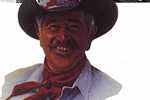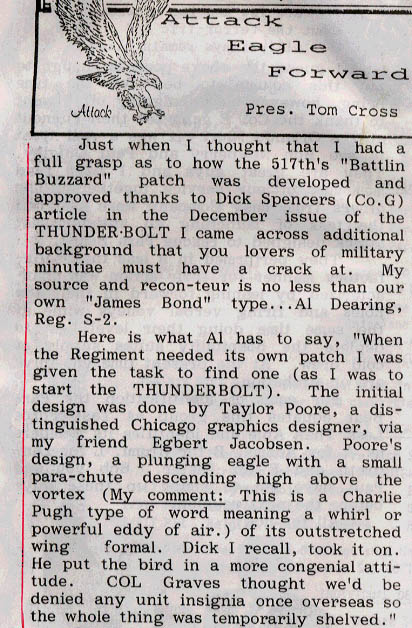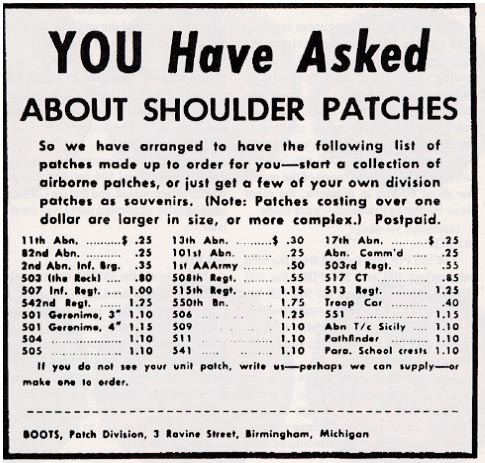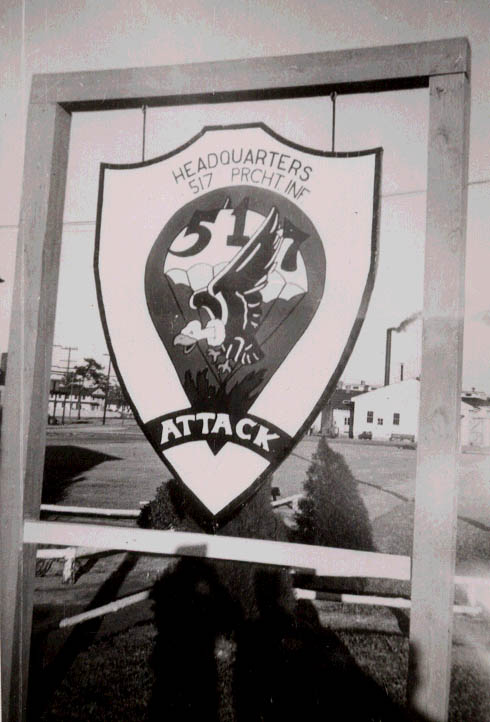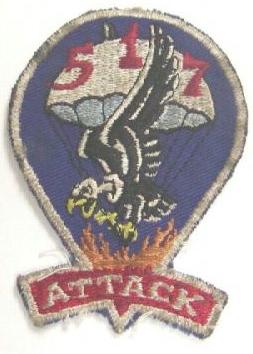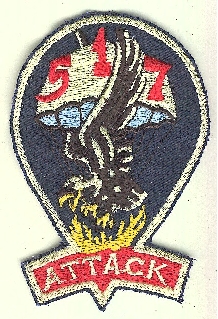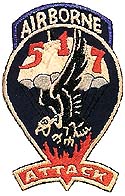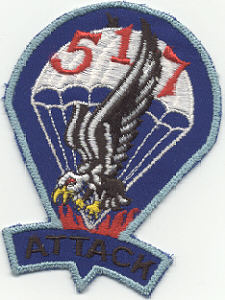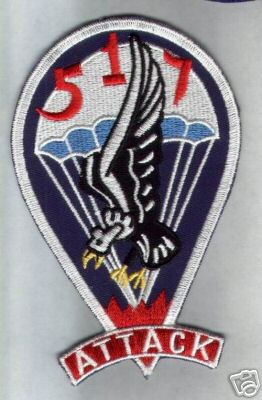|
According to Tom Cross: The patch was designed by Dick Spencer of the 3rd Battalion 517 PIR. Someone said it was made to look scrawny as a left handed salute to Colonel Graves.
It was never officially authorized as far as I know. Dick Spencer drew it and we did what ever we wanted or I should say could get away with. I do not remember any official document stating where and when it would be worn on an article of uniform clothing. It was used mostly on invitations, papers, booklets etc. The 2nd Battalion scroll described in your message and shown in the First Airborne Task Force book is a new one on me. The only time I saw it was in the book. It was probably personally designed by the wearer who had it made up by someone in Nice with a sewing machine. Some of the men also had their long GI overcoats cut short and this too was unauthorized. I was standing beside Colonel Graves when he really got upset about the short overcoats and the blackened helmets that had been used for cooking rations etc. This event took place when the Regiment was making its foot march from the Maritime Alps positions to La Colle-Sur-Loup outside of Nice. The end result of this was a rigid training cycle that commenced in earnest when we closed on Soissons before heading to Belgium and the Bulge. Follow-up from Les Hughes (January 2007) I read the material on your website, attributed to Tom Cross, regarding the design of the 517 patch. I corresponded with Dick Spencer in 1986 in the course of researching a magazine article on WW2 airborne insignia, and he provided his recollections of the origin of the design. In fact, it may have been my contact with Dick, and with Tom, with questions about the patch's origin that prompted an article by Dick in the December 1986 issue of Thunderbolt (an issue I appear to have misfiled). All this came to mind recently when I was contacted by an insignia collector who wanted information on original 517 patches. (I have a non-commercial website, www.insigne.org, that attracts a lot of inquiries regarding insignia.) Anyway, in digging through my files, I found the March-April 1988 issue of Thunderbolt, in which there is an aspect of the patch's history that I, and perhaps Tom Cross, too, had forgotten. I scanned the pertinent information and have attached it. I also found in my files a snapshot, apparently plucked from someone's scrapbook, judging from its back, showing the 517 patch logo on a sign hanging outside 517 Prcht. Inf. Headquarters (below). The photo appears to have been taken in the States, which would date the design to before the regiment's leaving for Europe.
Les Hughes
Follow-up #2 from Les Hughes (January 28, 2007)
Bob,
There have been two 517 patches, of which I am aware, on eBay recently. One was handmade; the other, the patch to which you referred in your note, was a US-made example. Assessing whether a handmade 517 patch is genuine is especially problematic, because there are so few documented, genuine examples available for comparison.
The US-made example (illustrated in example #2 above right: a red field behind ATTACK with orange flames above) is one of at least two US-made versions that many collectors accept as genuine, although “of the period” is probably a more accurate description, given reports that US-made patches were not available to the unit in Europe. In fact, I acquired an example of this patch in the mid-1980s from a 517 veteran who was certain that he’d gotten it while in the army (he had never attended a reunion). Might his recollection of how he had come to have the patch be faulty after 40 years? Yes, there is that possibility.
The values of genuine examples of the insignia of WW2 airborne units—especially of regiments and of the few independent battalions—have increased steadily from when I first began collecting in 1983. The same applies to most airborne-related artifacts of WW2. But compared with collectibles such as stamps and coins, whose values are catalogued, the values of military artifacts are rather subjective. While the price that a particular patch realizes on eBay may serve as an indication of its value, there are dynamics on eBay—in any auction—that can push the final price beyond what is reasonable. I have seen numerous instances where two examples of the same item sold on eBay, within a month or so of one another, for prices that differed by as much as a factor of two.
Insignia collecting reached its zenith during World War II, and although interest in insignia has diminished since then, it has never vanished. To feed this interest, copies of insignia have been made for decades. Many of these copies have been sold as such for modest prices; others, however, have been made to deceive. And some of those made and offered as copies years ago—for example, in the late-'40s or early-'50s—have, after passing through several owners and acquiring a patina of age, today are considered genuine by some collectors. More than a few veterans have acquired copies of their unit's patches at reunions or through magazines that attract veterans. Often these copies make their way into the veteran's wartime memorabilia, so that years later, when a collector acquires the veteran's memorabilia from the family, the copy is judged to be genuine because “it came from a vet.”
The following link will take you to an advertisement on my web site. No, it's not an ad for something that I am selling, it is in an ad that ran, in 1946, in Boots, a magazine for airborne veterans (something like Static Line) that existed for a short time following World War II.
from http://www.insigne.org/images/Boots.jpg :
As you can see, the gist of the ad is that Boots has commissioned the manufacture of copies of the patches of most WW2 airborne units for sale to its readers. In some cases, the patches are for units (505, 550) that did not have patches during the war, only crests, on which these patches are based. In is sources such as this, I am convinced, that account for many of the US-made examples regimental pocket patches that one encounters today. (The patches available to some units—e.g., 509, 517, 551—were made locally, in theater, and yet today one finds US-made examples of these patches that appear to date from WW2. I know of at least two 517 patches that fall in this category.) And having been made immediately after the war, undoubtedly by the same companies that made patches during the war, the materials and construction of the patches are essentially indistinguishable from those made during the war.
As I note above, the original patches of some units (including the 517) were procured locally overseas. Patches of this type, so-called theater-made patches, typically were made by hand, in relatively small quantities, and often exhibit high-quality workmanship. Genuine examples of these patches are much sought after by collectors and command some of the highest prices paid for insignia. This has led to the creation of what is almost a cottage industry making high-quality copies of theater-made patches, many to dupe collectors. In some cases, these people produce examples of patches that never actually existed but whose designs seem plausible—what I call fantasy insignia. In Italy, for example, as American troops occupied the country, many local businesses worked to attract GI dollars. Veterans of the 509 have told me that in Naples, near which they were based for a while, there were shops, indeed vendors on the street, who offered handmade examples of American insignia; and if they didn't have what the vet wanted, they would make it to order. Understandably, one finds significant variability in the materials and construction techniques in the patches from such sources. This plays into the hands of the people who now are manufacturing such patches to dupe collectors: a collector who finds a theater-made patch that differs a little bit from what he has seen the past attributes it to the natural variability of such patches. That's not to say the people making these fakes do not do their homework: whenever possible they use genuine patches as guides, and the results are sometimes frighteningly spectacular.
I apologize for the extended discourse on something about which he may have only passing interest. I do so just to give you an idea of how difficult it can be to determine whether a patch is genuine.
I spoke and corresponded with Dick Spencer while gathering information on the origin of the 517 patch for a magazine article dealing broadly with airborne insignia of WW2. I will close the pertinent portions of two letters from Dick.
The excerpt I sent to you yesterday from Tom Cross's "Attack Eagle Forward" column in the March-April 1988 issue of Thunderbolt puts forth an origin of the patch's designed that is a little at odds with Dick's recollection. There, Al Dearing states that the original design was the work of Taylor Poore, "a distinguished Chicago graphics designer," and that Dick Spencer's role was one of modifying the design. Dearing describes the design as depicting an eagle, not a buzzard.
To all of this I can add the photo in the attached image. I do not recall who gave me this photo—I found it in my file on the 517th without any supporting information. Judging from paper stuck to the back of the photo, it was pulled from someone scrapbook. Two aspects of this photo are noteworthy. First, the buildings in the background suggest that the photo was taken in the States. If that is the case, it dates the patch's design to before the unit left for Europe. This is not at odds with Dick Spencer's comment: he states merely that the first patches based on the design were made in France, not that the design originated there. Second, the bird on the logo in this photograph appears to be a buzzard; indeed, the design of the logo here and appears to be its final form. This is not inconsistent with Dearing's version, it would simply mean that Spencer made the modifications to Poore's design before it was ever executed in any form, including signage.
Again, I apologize for the length of this note and if I have tended to ramble in places. In you have any questions, or if I can be of further assistance, please let me know.
Les
Follow-up #3 from Les Hughes (January 282007)
Bob,
It was only today that I looked at the appended
eBay page for the 517 patch you sent, and it is not the one I discussed
in my email. ...
What is interesting about this particular patch is that the person who
won it is someone I know. He contacted me today to pass along some
information regarding his win. He posted a bid at the last second for
far more than he wanted to pay, but he wanted to ensure he got the patch
and, besides, he didn't think anyone else would bid nearly as much. He
paid the seller electronically (via Paypal), and the seller said he
would send the patch via Express (overnight) mail. The Express envelope
from the seller arrived today, and it was..... empty! In the meantime,
for unknown reasons, the seller has been suspended from eBay. Now, the
buyer has to try to recover his money. I doubt it will be easy (the
seller will claim, of course, that the envelope contained the patch.)
It's a jungle out there!
Les
|
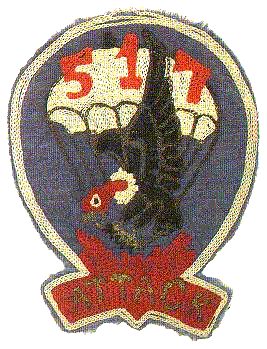
|
|
Howard Hensleigh - March 16, 2007
Dear Ben: Sorry to be late; my first answer disappeared and
went I know not where. Here is a second try.
First, I assume the "patches" are the 517th buzzard, the 460th kicking mule and the 596th trooper with the mine detector. The short answer is that none of them were ever officially recognized by the Army and even though available long before the unit disbanded, officially we did not wear them on our uniforms. The rest of the story fits into the history of the outfit as one of the many unique contributions made by combat team members. The "patches" were a products of the talents of Dick Spencer, a G Co platoon leader and later 3rd Bn. S-1. As we all know now, the combat team was composed of many talented troopers. Each did his part to make it a unique outfit. A few like McQuade did his part in combat and faded away into oblivion after the War. Dick did his part in combat and was wounded several times for his efforts there. He also contributed to the morale of troopers and their units whenever he could. Dick was a high profile journalism student and cartoonist at Iowa U. He took his portable typewriter with him when he swapped his cowboy boots for jump boots. Jo Spencer still has Dick's beat up portable used to record our history and send news releases to papers at home. Before we left Italy Dick had written a booklet describing the campaign calling the outfit the battling buzzards. He said this name fit because we were a small unit attached to larger ones that gave us dirty combat jobs to clean up. He came to this conclusion earlier than most, a fact we all realized by the time we left the Bulge and Bergstein. The book "Battling Buzzards" erroneously concludes that Dick manufactured the three "patches" after the War. The emblems of the three elements of the combat team appeared much earlier, possibly when the booklet on the Italian campaign was published. Dick came up with Christmas cards and other items when he thought the outfit needed them. He thought the three elements of the outfit needed their own distinct symbol for morale purposes. He supplied them long before the War ended. Possibly Astor thought that no combat team would have the guts to produce its own "patches" without official blessing of Army. The talents of our troopers frequently exceeded the expectations of the regimented minds of our superiors as they did in our "requisitioning" the transportation we required for prolonged periods combat. When our victory ship pulled into New York harbor the battling buzzard in color from the deck to the top of the mast was there in color. The riggers had pieced it together from colored equipment bundle chutes. It was clearly visible a mile away. It was the outfit's way of demanding a little recognition. I think the patches we did wear were the patches of the 17th Airborne Division, the 5th Army, the 18th Airborne Corps and, reluctantly, the 13th Airborne Division. If anyone else has recollections, lets have them. Highest regards, Howard Hensleigh |
